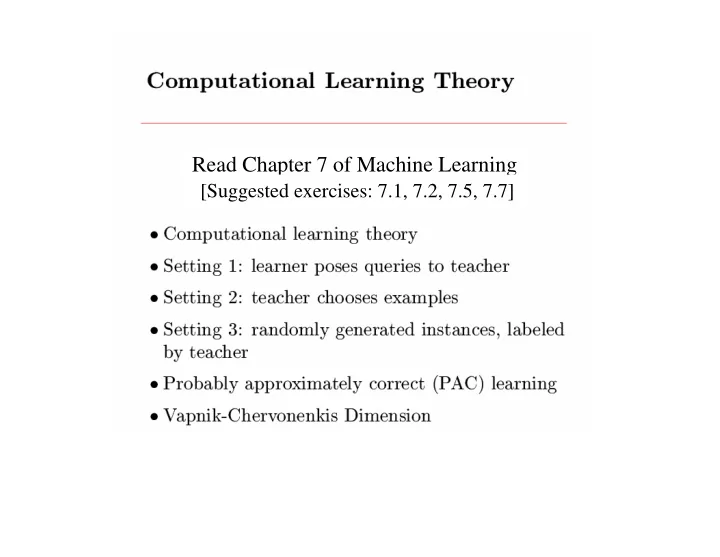

Read Chapter 7 of Machine Learning [Suggested exercises: 7.1, 7.2, 7.5, 7.7]
Function Approximation Given: • Instance space X: - e.g. X is set of boolean vectors of length n; x = <0,1,1,0,0,1> • Hypothesis space H: set of functions h: X � Y - e.g., H is the set of boolean functions (Y={0,1}) defined by conjunction of constraints on the features of x. • Training Examples D: sequence of positive and negative examples of an unknown target function c: X � {0,1} - <x 1 , c(x 1 )>, … <x m , c(x m )> Determine: • A hypothesis h in H such that h(x)=c(x) for all x in X
Function Approximation Given: • Instance space X: - e.g. X is set of boolean vectors of length n; x = <0,1,1,0,0,1> • Hypothesis space H: set of functions h: X � Y - e.g., H is the set of boolean functions (Y={0,1}) defined by conjunctions of constraints on the features of x. • Training Examples D: sequence of positive and negative examples of an unknown target function c: X � {0,1} - <x 1 , c(x 1 )>, … <x m , c(x m )> What we want What we want Determine: • A hypothesis h in H such that h(x)=c(x) for all x in X • A hypothesis h in H such that h(x)=c(x) for all x in D What we can What we can observe observe
Instances, Hypotheses, and More-General-Than
i.e., minimizes the number of queries needed to converge to the correct hypothesis.
D Set of training examples instances drawn at random from Probability distribution P(x)
Can we bound in terms of D ?? D Set of training examples instances drawn at random from Probability distribution P(x)
true error less
Any(!) learner that outputs a hypothesis consistent with all training examples (i.e., an h contained in VS H,D )
What it means [Haussler, 1988]: probability that the version space is not ε -exhausted after m training examples is at most Suppose we want this probability to be at most δ 1. How many training examples suffice? 2. If then with probability at least (1- δ ):
Sufficient condition: Holds if L requires only a polynomial number of training examples, and processing per example is polynomial
true error training error degree of overfitting
Additive Hoeffding Bounds – Agnostic Learning Given m independent coin flips of coin with Pr(heads) = θ • bound the error in the estimate • Relevance to agnostic learning: for any single hypothesis h • But we must consider all hypotheses in H So, with probability at least (1- δ ) every h satisfies •
General Hoeffding Bounds When estimating parameter θ ∈ [a,b] from m examples • When estimating a probability θ ∈ [0,1], so • • And if we’re interested in only one-sided error, then
Recommend
More recommend